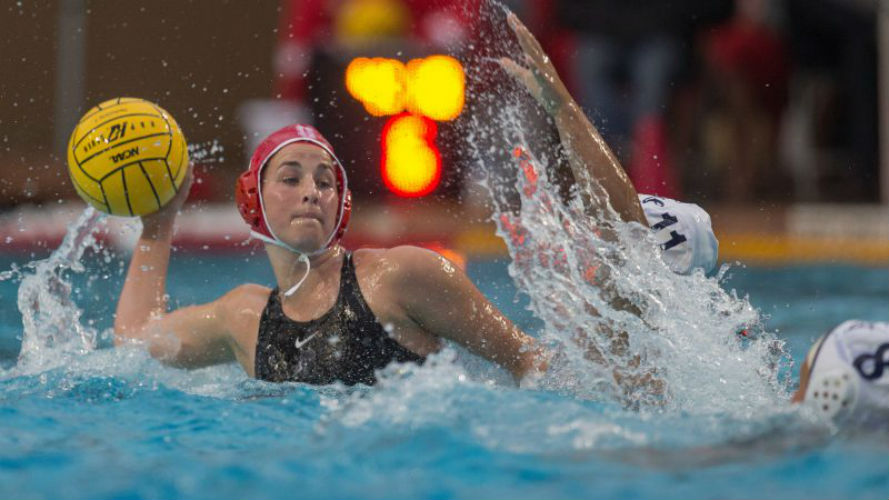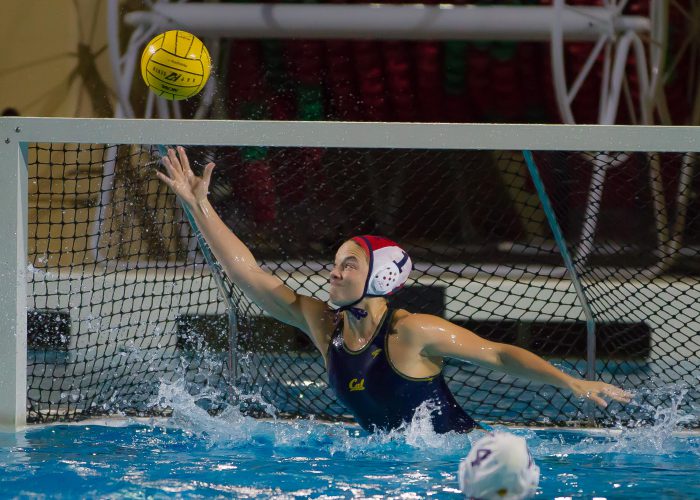In Battle of Bay Area Rivals, Stanford Prevails over Cal in Women’s Water Polo

By Michael Randazzo, Swimming World Contributor.
Last weekend at the 17th annual Stanford Invitational, the host Cardinal’s top-ranked women’s water polo team passed its first big test of the season with a 10-7 win over #4 U Cal Berkeley (8-1). The victory assured that Stanford (7-0) would remain the nation’s top-ranked team for at least another week, with #2 USC (10-0)—which is unbeaten in its last 37 matches—and #3 UCLA (7-0) just behind.
This year’s Invitational presented a number of compelling storylines, none more significant than the return of senior Maggie Steffens to the Cardinal roster following a year off pursuing Olympic goal in Rio.
Steffen’s coach, John Tanner, was effusive in his praise for his captain, already a two-time Olympic gold medalist: “Maggie is just an incredible leader, an…extremely diligent athlete and one who trains so hard,” he said by email following Sunday’s championship. “She’s a great role model.”
Joining Steffens on the Stanford roster was fellow Olympian Makenzie Fischer, a freshman making her first appearance at the Invitational and another reason the Cardinal presents an imposing challenge in this post-Olympic year.
Looking to crash the Cardinal’s pool party was an undefeated Cal squad sporting three Olympians of its own—Dora Antal and Anna Illes of Hungary and Roser Tarrago of Spain—as well as a new coach with an Olympic pedigree and strong ties to many of the featured players at the eight-team tournament.
For Coralie Simmons, tapped last fall to join a storied Bear program that lists 14 NCAA titles on the men’s side—including the 2016 championship—but none on the women’s, the Invitational was an opportunity to see her young squad match up with the sport’s best.
“We attacked the game with a lot of energy and rivalry getting in the pool with Stanford,” Simmons said following the match. “We had a good surge in the middle quarters but came up short in the end.”
The new Cal coach, a member of the U.S. squad that captured silver at the 2000 Olympics in Australia, spoke with confidence about her team’s interesting mix of young players (17 underclassmen) and athletes with international experience: “We have a strong and experienced upper class, athletes who, when things are tough, our young athletes are going to learn from and [whose experience] they’re able to fall back on.”

Photo Courtesy: Peter Trabucco
Also in the Mix, a Midwest Power
A counterpoint to the rivalry between the two Northern California teams was provided by #7 Michigan and their head coach Marcelo Leonardi. The Wolverines came into this season following an outstanding 2016 that saw them win 30 games while achieving their highest-ever ranking (#4), after a fourth-place finish at last year’s NCAAs.
On the Invitational’s first day, Leonardi faced Cal’s Simmons, his former assistant on the U.S. Women’s Youth National Team. Both admitted to no hard feelings as the Bears topped the Wolverines 13-9.
“Coralie and I have a great relationship. The rich conversations that we have, from technical to tactical to motivation, to things that are happening in our families,” Leonardi said later, following his team’s 8-6 win over Hawaii in a third-place match.
A part of Leonardi’s staff for the past four years—including 2014, when the U.S. won gold in Madrid at the FINA World Women’s Youth Water Polo Championships—Simmons not only knows many of the athletes competing at the Invitational, she’s very familiar with her mentor.
“We know each other very well, not only on a personal level but professionally,” she said. “We have [insights] on each other—[it’s like] Cliff Notes on what the next move is going to be.”
Home Team Holds On
But in Sunday’s final it was the Cardinal holding off the Bears to take the title back from Cal, last year’s winner, in what the Stanford coach acknowledged has implications for the NCAA tournament in May. Last year, only four teams from the Mountain Pacific Sports Federation—Stanford, UCLA, USC and Arizona State—made it. Cal was the odd team out.
“Qualifying for NCAAs is a big deal,” said Tanner. “You get the automatic [bid] by winning your conference tournament, but it’s not a given, so these [matches] are a big deal.”
Now that he has his full roster back, Tanner admits that his biggest challenge may be managing his players’ expectations.
“They’ve always seen the bar as being set high, and that’s the way it is with our program,” he explained. “However you want to contextualize it, it just comes down to the fact that they have high expectations for themselves every day throughout all their endeavors on campus.”



